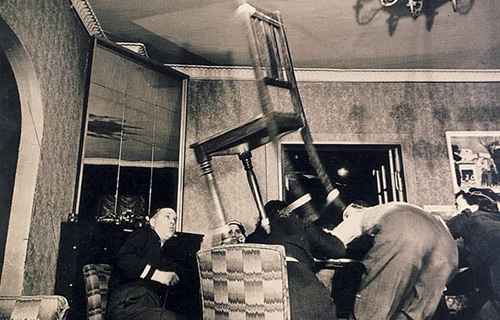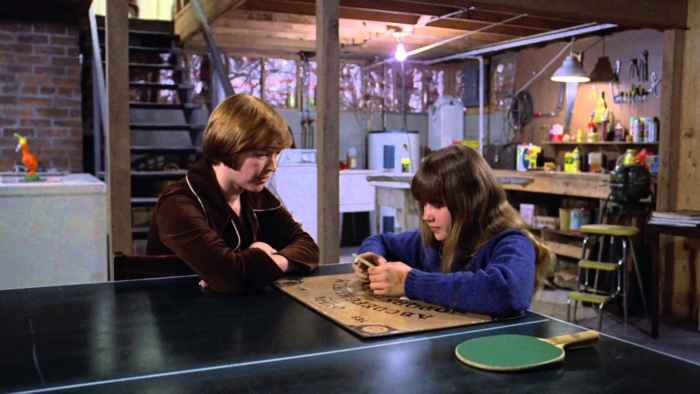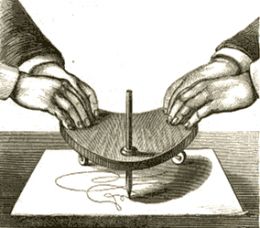Ouija Boards in Movies
In horror movies, the use of an ouija board is a well-known cliché. An ouija board is a wooden board with letters written on it. This board is usually used in groups, where everyone in the room holds onto a wooden planchette, which usually has a glass hole near the tip, which allows people to see the letter that the piece is over. The idea is that the spirit will guide the planchette to create a message from the letters. Ouija boards have their set of superstitions associated with them, and often in movies, they are portrayed as potentially dangerous tools used by unwitting people.
It’s like a window into the afterlife
Ouija boards are a novelty item that can be found in any supermarket. Horror novelist HP Lovecraft once said that “The oldest and strongest emotion of mankind is fear, and the oldest and strongest kind of fear is fear of the unknown.”
Ouija boards take advantage of the fear of death. No one knows what happens in the afterlife. The ouija boards have the supernatural ability to take information from the place where no one goes. However, unlike those on the other side of the grave, the ouija board users operate blind. They can’t see the spirits around them or their intentions. This asymmetry in perception creates the sense of dread during seances.

The atmosphere around the board creates a sense that there are malevolent forces waiting in the shadows. The Uninvited, an early horror film depicts the users of the board inside a haunted mansion, which is a horror trope similar to one striking oil in the middle of the desert. The potential for disaster is amplified by danger presented by the surroundings.
Unlike most horror tropes, ouija boards are commonplace in real life
In the early twentieth century, ouija boards (then known as talking boards or spirit boards prior to Elijah Bond’s patent of the ouija board), grew in popularity. One example is that of famous author GK Chesterton who experimented with boards in his youth. It was the Bloody Mary of the time, something even a stupid teenager would do. Most horror movies involve tropes that are far removed from reality, like supernatural monsters, undead creatures, supernatural abilities, etc, not often present in the real world. One can’t see a vampire or zombie in real life.
This shows in the way they are depicted in early film. While one might think of movies like The Ouija Experiment, ouija boards often take their place in the background. The vampire, the werewolf, or the haunted house often act as the main attraction in a film. In one example, the Bat Whispers, a black and white film from the 1930s, a ouija board appears as the two main characters perform a seance with a ouija board after a mysterious figure known as “The Bat” appears to harass the residents in the mansion. Even though it is a non-horror movie, this scene works. The board serves as a way to depict the superstitious attitudes of the women. The idea of a werewolf walking on the set and trying to comfort the ladies sounds absurd, because it is. There is no real world werewolf, but there is a real world ouija board, albeit one whose powers are probably exaggerated.
Ouija boards are the modern Pandora’s box
The idea of a demon being accidentally released into the world through a ouija board is probably the most common depiction of the ouija board. The Exorcist is more or less the basic template of this idea. It’s a trope that goes back to ancient times. If one imagines the ouija board as a box, and imagine Regan as a young woman living in ancient Greece, then we have Pandora’s box. Her use of the board, out of a sense of curiosity is what leads to the release of evil, in this case, the Christian devil.

In another variation of the trope, sometimes the ouija is used for positive means, but ends up causing more harm than good. In American Horror Story: Coven, a witch named Zoe Benson attempts to contact her friend Madison through a board, but instead of contacting the intended spirit, she awakens the New Orleans Axeman, who then goes on a rampage. Often the spirit that makes contact with the users of the board are ancient demonic entities.
Ouija board’s cousin: automatic writing

While ouija boards have broken into the mainstream, automatic writing has not. Automatic writing is based on a similar principle as ouija boards except that, rather than guide a planchette on a board to create a message, the message is written on a piece of paper below the planchette. It has appeared numerous times in literature, but has yet to make the same impression in the minds of horror aficionados as the ouija board.
One major problem with automatic writing in the modern horror genre is that it resembles ordinary typewriting and digital documents. What may have horrified people in the nineteenth century would probably be laughable in the world of print dominated media. While this may not be the cause of the lack of awareness of automatic writing, it certainly is a problem when trying to convince the viewer that a person writing an “automatic” message on a scrap of paper isn’t just using a keyboard hidden under the desk.
Ouija boards are able to evoke our deepest fears about death and the unknown. It’s no wonder then that movies like The Exorcist have the power they do. They expose some of our deepest existential fears about the unknown, about things that we can’t see. It’s likely that ouija boards will never stop being the horror trope that they are. It’s too human to wonder what happens to the spirit after death.
What do you think? Leave a comment.











We used to use an upturned glass and a circle of bits of paper with letters of the alphabet when we were at school, in the seventies. Called it ‘spirit in the glass’. Probably couldn’t afford the real board.
Probably couldn’t afford the real spirit either.
My mate Skunky Billy from down ‘The Feathers’ told me the that in the 1920s the ‘Ouija’ people prophesied that they would produce a sort of mobile spiritual hand held communicator in less than a hundred years, but that due to its unearthly power it would explode in the hand and fail.
They actually did it Shani! It was made by Samsung!
Ouija…two words French for yes and German for yes. So isnt it a Yes Yes board?
The next US general election should be decided by Ouija board. Save us all a lot of grief.
In some ways I’m quite bound by the scientific worldview, to the point where I feel constrained by it (I’m an engineer). But in spite of that, I’ve always been too afraid to even try a ouija board.
Mucked about with this in school with a bit of paper and a glass. Scared the bejeesus out of one of my more gullible friends. Yes, it was me pushing the glass about.
I would suggest that people do not do this for a bit of fun, even if you are sure that its a load of bollocks.
Why not? I have a board and have yet to experience anything that could remotely be described as supernatural. It’s a toy; you push the planchette around subtly to scare the weaker minded in the room.
We had a Seance once! We managed to contact the spirit of a former athlete called Thomas! We asked Thomas what he did to pass the time in the spirit world? He replied that he managed to keep himself fit with regular Exorcise!
Remember my childhood and the mysterious Ouija board! The mind can be powerful. (religions, belief in the Bible, superstition, meditation, prayer, positive thinking, cults and psychics -all in the mind)
I did a few ghostwatches when I was a teenager, one organised by my sixth-form college and a few in local pubs and other places that they’d all organised themselves (the point being that they were all organised separately from each other.) and they all, strongly and unequivocally forbade any participants from bringing a Ouija board, and said anyone found with one would be asked to leave immediately. Neve saw a ghost, but did see a few people sneakily using the boards, needless to say to no effect whatsoever.
Probably because teenagers inevitably use them to piss about.
Some years later I used it with a group of colleagues at work and subsequently was plagued with a series of very dark nightmares over a lengthy period of time.
Put it this way, I can see where Stephen King gets his ideas from.
When I was a very young child a friend of mine at school died suddenly and unexpectedly. This being an unfamiliar and confusing experience, I remembered once upon a time hearing about people communicating with the dead through ouija boards. I made my own with a toy chalkboard and a little piece of chalk. I wasn’t sure exactly what to do, so I just asked questions out loud and hoped she was listening.
Nothing happened.
Ouija boards are for wimps; tarot is hardcore.
I once had a funny experience with a Ouija board.
It was just an ordinary day and I was in my usual spot, when all of a sudden I heard a voice asking: “Is there anybody there?” Well, I just had to go and find out who was asking and what it was all about. I followed the voice to an upstairs room in an ordinary apartment building and found a group of teenagers sitting around a Ouija board with their hands touching the board’s pointer. So, just for fun, I started pushing the pointer around to the word “Yes”. That startled them! Then they asked me all sorts of questions and I answered them using the pointer. I just made up any old nonsense, but they couldn’t get enough of it; at least until they started getting scared. Eventually they got so scared they told me to go back where I came from. So I did.
It was the best fun I’d had in – oh, I don’t know how long it’s been. But it was good to be out and about for a change.
It’s very dark and lonely here where I am.
I did one once, nothing happened.
Did you get your money back?
I remember girls at school when I was a teenager, late 80s/early 90s, using Ouija boards at break and being freaked out by them, so we had an assembly about it where the Headmistress told us in no uncertain terms that Ouija boards were evil (?) banned and anyone found using them would be suspended.
A group of students at our college was using one, and summoned up the devil. As they finished doing so, a particularly unpopular tutor walked in…
I’ve never seen a Ouija Board but, when I was a teenager, a glass, a circle of letters and some talcum power to make the table nice and slippery did just fine. The best experience was when the table lifted itself spontaneously into the air.
I love Ouija boards, as long as I get to be the hat.
I had a spooky experience with a Monopoly board once.
I can’t tell you about it, though, because the demon of unrealistic gaming capitalism said he’d eat my face if I did.
An enjoyable essay. I really never gave ouija boards much thought when I’ve seen them in movies.
An interesting topic, I just wish further films use had been examined to explore the range of interpretations.
ouija boards are something that in movies seems to be a very pigeon-holed trope. If it is directly involved in the story, especially in horror movies, it always seems to fall into the “accidentally contacting the wrong spirit” storyline or an alteration of such. While it is a fun thing and as you said a very realistic stereotype as they exist in the real world, it is something I feel like has been done to death.
The idea of Ouija and all it’s glory is that it relies on personal beliefs as well as the build up of information gathered around them. Although people are afraid of death and the unknown, they also crave the gains received from building onto the curiosity of something that will probably never be truly revealed. Now Ouija and other incidents related to the unknown has become part of a business ploy. This is another representation of capitalism as topics that truly do hold significance, or do they? In a cultural determinist perspective, society’s constant discussion of the unknown and the triggering effects of curiosity has naturally led businesses in the path of revenue from a topic once considered sacred as mentioned above regarding the difference of what would scare previous centuries.
I think the use of the Ouija board in movies and other genres has a deeper implication than simply a fear of death and/or the unknown. The supposed power of the Ouija board is that one can bring an entity through, usually something malevolent but sometimes something that brings no harm. However, the entity that comes through does not come through the board itself. The entity can only be brought forward if a person is using the board. Thus, the person him or herself is the conduit, the doorway for evil to enter the world.
In many movies, the conduit is innocent. The author uses Regan from the Exorcist as an example. The Exorcist is the perfect depiction of why the Quija board in film is so terrifying. It is not the idea of death. It is the idea of violation. Regan does not invite Captain Howdy to invade her body. She is an innocent victim who doesn’t realize that she is, in fact, prey. Captain Howdy violates her body. In turn, Regan descends into madness, violence, the opposite of everything that she was at the beginning of the film. Notice that in the majority of films the user of the Quija board is female. If we think in symbolic terms, an evil has entered the innocent female’s body and wreaked havoc on who she is physically, spiritually, and mentally. There is a complete loss of control. The evil entity has stolen her body and identity. She has to fight to regain who she is and must defeat and expel the evil that has forced itself on her.
I would argue that a violation such as this is more frightening than death. Death has a finality. Violation has ongoing implications of torment and suffering that seem to have no end.
A good read!
I wonder what the author thinks about that scene in “Breaking Bad” where the Salamanca twins visit their uncle Héctor in the retirement house and use a ouija board to get the name of Walter White.